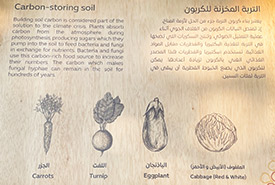Working landscapes, conservation and COP28: my takeaways

A wooden panel describing the importance of building soil carbon (Photo by NCC)
As the manager of agriculture policy for the Nature Conservancy of Canada (NCC), I went to COP28 to understand how agriculture and ranching contribute solutions to the climate crisis. Here’s what I learned:
⚡️ The ambition is energizing
COP28 was the largest climate COP yet. Participants showcased a plethora of science-based solutions, technological innovations, and partnerships happening between governments, industries, organizations, communities and individuals around the world. Witnessing the level of response to climate change was valuable to understanding how NCC’s work can and does contribute to these global efforts.
🌱 Invest in people
To secure a resilient world, we must invest in grassroots community health and development collectively, even if it seems outside the scope of an organization or project. This approach develops a community’s capacity to contribute to solutions for climate change and biodiversity loss. This inspires me to explore how the conservation community can bridge solutions that create compounding benefits for climate, nature and people.
🍽️ Community cross-pollination needed
Agriculture and nature were prominently featured at COP28. Their role in climate solutions is being more seriously acknowledged. However, dialogues still felt as though two separate tables were set: the agriculture community, and the conservation community, each presenting their own solutions to climate change. While the ideas overlapped, each community was at their respective table, waiting for the other to appear. The scale of climate change demands that we all sit together, making space for everyone.
🌾Food security bolsters resilience
Working landscapes can support nature and climate goals. We can set our dinner tables with healthy food that is produced while protecting the plants and animals we cherish, the carbon they help secure, and the local economies that our food systems support.
💪 We translate ambition into action
My pride in our work at NCC was deepened by my time at COP28. We’re transforming global ambition on climate change and biodiversity loss into on-the-ground action in Canada. My NCC colleague Rob Wilson demonstrated some of these successes at COP28 during a Canadian Pavilion event with the Canadian Cattle Association. This event showcased how our collaborative work to protect grassland ecosystems safeguards both biodiversity and carbon sequestration on these landscapes, while supporting the Canadian ranching community and the food they provide.
Throughout the convention, one thing was made clear to me: NCC is setting a table for everyone. With our partners across governments, Indigenous Nations and communities, as well as industries, we can protect and connect resilient landscapes that support people, biodiversity and the climate. Want to be part of the solution? Reach out and we’ll find a seat for you.


